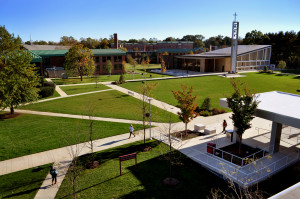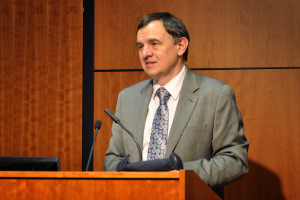Economic report comes with a report card
Connecticut”™s economy is expected to grow between 1.8 percent and 3.2 percent in 2015, with the state”™s unemployment projected to fall to 6.8 percent by the end of that year, according to a new report.
Notably, the report is not a product of the usual suspects; rather, it represents the culmination of a semester-long course in economic and financial forecasting taught by Lucjan T. Orlowski at Sacred Heart University”™s John F. Welch College of Business.
Orlowski said this was the second time he tasked his students with assembling a report on the state”™s economic outlook, with the previous group reporting on Connecticut”™s economy in May 2011.
“In my class, students learn advanced analytical skills that are necessary today to conduct economic modeling and forecasting. This comprehensive project gives them the opportunity to apply these skills in the real world, as they formulate forecasts for various sectors of the state economy,” Orlowski said in an email.
The report notes that while the U.S. economy has shown signs of improvement since the end of the recession, Connecticut”™s economy has lagged, drawing comparisons to previous economic slowdowns and what is traditionally a delayed recovery in the Constitution State.
Based on an analysis of factors such as housing starts, bank lending, exports by Connecticut companies and the condition of the state”™s budget, the students determined that the Connecticut economy would likely grow at a rate of 2.5 percent in 2015, with a worst-case scenario of 1.8 percent growth and 3.2 percent growth representing the best possible outcome.
The students determined that the state”™s unemployment rate ”” currently at 8.1 percent ”” would likely dip to 7.2 percent by the end of 2014 and 6.8 percent by the end of 2015.
On the surface, Orlowski said the report “has clearly demonstrated the urgent need for deep structural adjustments to the economy of Connecticut” ”” namely, a revitalization of the manufacturing sector to take pressure off the financial services and an overhaul of the state”™s tax system.
Beyond that, though, Orlowski said the course seeks to draw attention to the lack of understanding of the state”™s economy, particularly in relation to the U.S. and global economies.
“There is clearly an insufficient debate about the urgent need for structural adjustments in the state”™s economy that would make Connecticut less susceptible to possible future financial crises and economic downturns,” Orlowski said. “By all means, state authorities will be well advised to initiate more active discussions about the necessary reforms and structural changes in Connecticut”™s economy.”
He said that with a better understanding of the state”™s economic workings, Connecticut graduates would be better prepared to enter the job market.
For his students, he said, “the project deepens their education and makes them better prepared for pursing job opportunities.”

